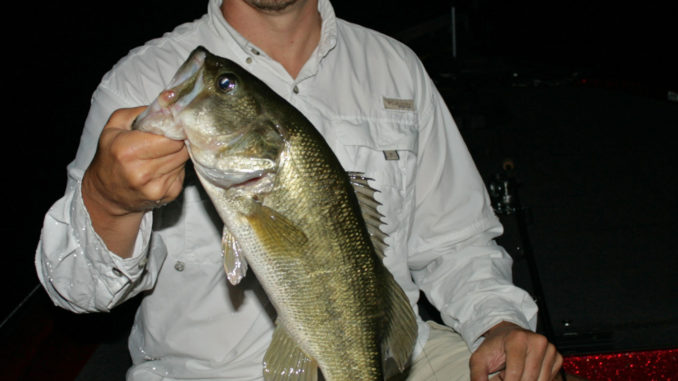
Early and late, it’s topwater time; move deep as day progresses
Lake Murray’s big largemouth bass are busting topwater baits early and late, and they’re also being caught during the middle of the day by fishermen willing to work through the heat and humidity.
According to guide Chris Heinning, it’s all about the bait, specifically blueblack herring.
“The forage is the key to the pattern I’m on right now for largemouth bass,” Heinning said. “With the onset of hot weather, the summer patterns have set in and the bass fishing is very good, but it’s a run and gun type fishing. When we get on the forage we usually find largemouth and that’s the key. I have to keep moving until I find the combination of blueback herring and largemouth.”
Heinning (803-905-1991) is getting out before dawn, and some of his best catches are on “walk-the-dog” topwater lures early.
“I go straight to the points and humps that have some wind blowing across them,” he said. “Some mornings are slick calm, and those are actually the toughest, because it’s harder to predict where the forage will be, but I just have to keep looking.
“One good thing about slack wind is you can see schooling fish and baitfish dimpling the surface better, so it evens out a bit. I prefer a 5- to 15-mile per hour wind; I will target the points and humps that have the wind sweeping over them. Topwater lures are great early and often throughout the early morning, especially if there’s some cloud cover.
“Most of the time, I start by fishing water that’s 10 to 15 feet deep – and sometimes even shallower. Generally, I’ll cast no more than 25 times before running to the next target unless we catch fish. Humps marked by buoys are great places to fish if you are not familiar with the lake. They’ve done a great job marking shallow spots with hazard buoys.”
Later, Heinning moves to points that drop off into deep water.
“Once it gets light, you’ll usually see the shallow points in the clear water that look brown because you can see the bottom,” he said. “The water drops quickly on most points, and the water is green where the water is deep. Fish the transition from brown to green water for big bass early in the day.”
Heinning said that the early morning bite slows when the herring move back into deeper water. He’ll turn to a Carolina-rigged worm, an Alabama rig and a shaky head worm to fish water 15 to 25 feet deep, or wherever he marks baitfish and bass on the points and humps. When fishing this pattern, his boat is often in 40 to 50 feet of water.
“Throughout July, there’s always a good chance of hooking into stripers up to 10-pounds, especially early and late in the day,” Heinning said. “So be prepared to handle that sized fish as well.”


Be the first to comment